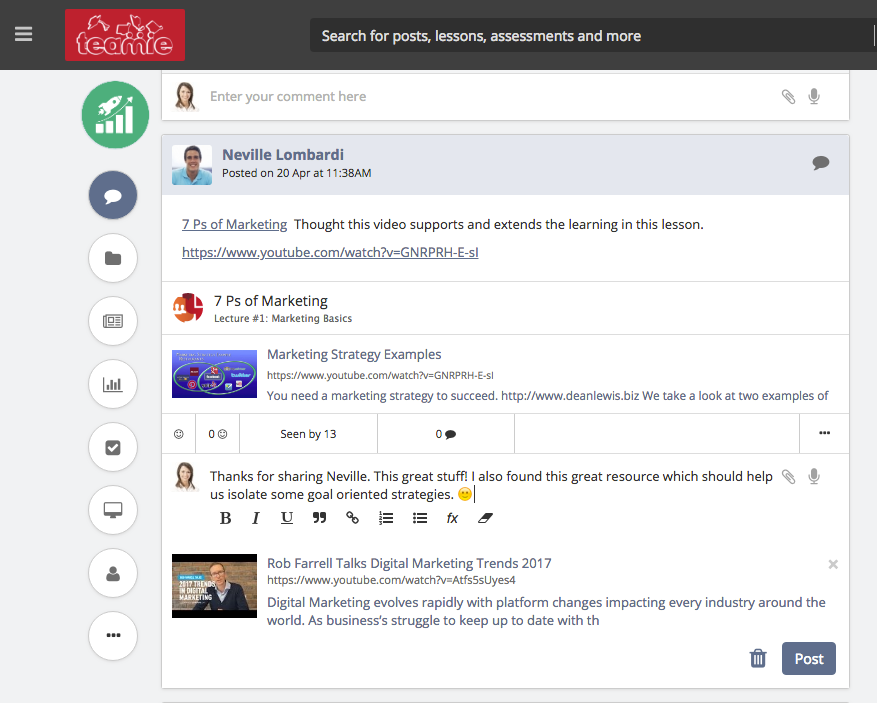We live in a world which is rich with information and where data and knowledge are powerful resources. With technological advancements, such as, the internet, smartphones and untold sources disseminating information, knowledge management has never been more important. The people within your organisation, can be your most important resources, if you can capture and harness their intellectual capital. Knowledge management is the key to effectively doing so and is essentially the vehicle for organisational effectiveness and competitiveness.
Having a clear strategy for effectively capturing, retaining and distributing the expertise, experience and knowledge of those within your company ensures that the organisation maximises the use of all knowledge resources. Today’s businesses and industries are battling against various factors that make it harder to retain, effectively harness, and apply intellectual capital, but there are tools, that probably already exist in your organisation or can be easily acquired, which can be leveraged to increase your knowledge management efficiency and effectiveness.
A Learning Management System (LMS) can be an organisations strongest tool for Knowledge Management, but is often under-utilised by organisations. If your organisation is simply using an LMS for delivering online units and multiple choice quizzes, it is being largely under-utilised. Advances in learning technology have given LMS’s far more functionality and potential, which if chosen correctly and leveraged properly have features and capabilities to drastically overhaul and improve an organisation’s knowledge management processes.
The major benefit of the current day Learning Management System is its ability to capture and curate the best knowledge from within the organisation. Let us look at some of the tips that will help you improve knowledge management by leveraging your LMS to make the most of your organisation’s hidden knowledge and how it can be used to revolutionise your company’s approach to knowledge management.
1. Create an Online Social Workspace for your Learners
To manage knowledge effectively, you need a robust platform which will support a multi-disciplinary approach, lead to meeting organisational objectives and allow you to capture and curate the intellectual capital in your business from different perspectives. An organised and long standing repository of intellectual capital is best supported by a system that is flexible and user-friendly. Housing this resource in an interactive and easily navigable platform will greatly support your knowledge management processes and efforts.
This can begin with taking stock of all the communication channels your organisation currently uses to share knowledge. This might include email, the company intranet, private YouTube channel, LinkedIn company page and other social networks. If it includes your Learning Management System then you are moving in the right direction. Once you have identified the avenues through which knowledge is transferred in your organization, the next step is to bring these channels together into one central and fluid delivery system, most adept for this, would be the LMS.
Just one example to showcase the importance of knowledge sharing is the onboarding of a new employee or an existing employee who has changed their business unit or role. In both the scenarios, employees should have easy access to the necessary resources and a LMS is a perfect way of doing so. Every effort that is saved in training these employees and the agility with which the training is executed, are direct savings for the organisation.
Also, knowledge is not static, it grows and evolves. If knowledge is socially constructed, it can’t grow if people can’t communicate. Therefore an LMS won’t be effective if it’s just dispensing eLearning units and quizzes. The best eLearning environment will allow knowledge to flow in both directions and let you create a learning community. A learning management system with social features, like those of popular social media apps, will offer countless opportunities for improved collaboration.

2. Get ‘Buy-in’ Throughout your Organisation
Having a strategy and a knowledge sharing platform is the starting point. In order to go deeper, a behavioural change and creation of a culture of knowledge sharing is necessary and the LMS is the foundation on which to build this. Everyone in your organisation brings a unique perspective and valuable insights, from the CEO right down to the newly hired intern. The issue then becomes, how to engage and then organise these diverse voices.
A flexible system with an open modular format will allow your company to set-up multiple and layered communication channels for knowledge sharing and knowledge creation. One may have only management and another may allow for the CEO and Intern to comment side by side on the same thread or resource.
The two biggest challenges will be a) Adoption and B) Sustained usage, i.e. growing your audience and keeping your audience. People will adopt if they feel their participation is contributing to some purpose and people will continue to engage if they can see that their efforts are leading to some larger goal. This is achieved by giving users some indication that their knowledge contributes to the wider business objectives. Both adoption and engagement in the knowledge sharing environment are supported by giving all employees a sense of ownership, in both the environment and the processes. This can be achieved through management participating in, and providing simple positive feedback in the form of various social feeds on your learning platform. Other features like gamification, where employees are awarded points and badges for engagement, works well for many organisations and individuals.
A blogging or portfolio component where staff can share knowledge or ideas gained in trainings, through attendance at conferences or simply through their own work experience, does wonders for employee buy-in. When people can showcase their work and ideas, it creates a sense of agency where they begin to see themselves as change-makers and innovators. Furthermore, utilising features like this sends a clear message about the value of sharing knowledge within the organisation. When it comes to creating a knowledge sharing culture with your Learning Management System, you should use every tool at your disposal to reinforce the message.
3. Generating and Mining the Knowledge
Previously we spoke of engagement, this was the precursor to the next stage of seeking out and curating the knowledge within the company. Gather what knowledge you already have in your possession (videos, interviews, PowerPoints, articles, documents etc.), where there is a gap, isolate subject matter experts within the organisation and make the best use of them.
You can isolate experts and knowledge sources simply by monitoring the quantity and quality of contributions to the learning conversations, collaborative projects or planning modules on the LMS. By tracking the users who contribute the most to conversations, you can tell not only who is in possession of relevant knowledge but also who has the willingness and disposition to share it with the organisation and their colleagues.
In a flexible modular LMS structure, that promotes social collaboration, you could easily set up ‘expert forums’ on the system, giving these individuals a platform to share their knowledge and expertise. It is also advisable to set up collaborative workspaces where groups of experts with shared or complementary knowledge can collaborate to create intellectual property that will benefit organisational goals. This elevated status on the platform can also act as an incentive for other learners. It encourages others to share their skills and understanding. You will find that there is likely a wealth of untapped skills, knowledge and intellectual capital hidden throughout your organisation which just needs to be drawn out.
4. Extract and Extend the Reach and Impact of Knowledge Resources
Rather than dumping content into learning modules or on the site in general, utilize LMS tools to build it purposefully. Thread related content/resources together to establish curriculum paths for core competencies which will support organisational goals. For example, a curriculum path may focus on building cross-cultural teaming excellence, and this could be achieved by building a succession of learning modules and discussions in collaborative or expert forums which are designed to nurture employee growth towards the goal. Other paths could focus on developing leadership, negotiators, and/or project managers. This similarly can be supported through creation of individualised learning plans and/or directing employees to relevant learning modules to support their goals, interest or career roadmaps. For these individualised learning plans to be effective the platform needs to have capabilities to systematically track individual progress toward competency goals and should also have some function for recognition of completions, like a digital certificate or badging system for their online profile.
Beyond being a repository for learning and training material, companies should be using their LMS to create collaborative workspaces and/or relevant discussion forums. By setting up this practice on your LMS, you can capture and create valuable new intellectual property and useful data on processes. By having a comprehensive record of these projects or business challenges in the database employees can learn from them, collaborate on possible solutions, or research them when facing similar issues in the future. All this information can also be analysed to identify and interpret trends, and identify process improvement opportunities.
5. Sustain the Effort
Knowledge management isn’t a one-time affair of collecting the knowledge in your organisation and depositing it in one place. We live in an ever changing world and rapidly changing work environment, thus the intellectual capital which an organisation thrives on needs constant maintenance and upkeep. The LMS users or employees are spending at least eight hours a day dealing with the realities of their business/profession in their jobs and hence they are the most equipped and best suited when it comes generating new knowledge and intellectual capital which is the basis for relevant updated content. This can happen through simple mechanisms like being able to give feedback directly on learning content and even suggest resources to support or extend it. Any user-generated content adds great value to your knowledge management processes as well as the training programs and it enhances the sense of ownership for the employees.

Source - http://www.projectvisit.org/knowledge-is-power/
Final Thoughts
Your organisation and business has a wealth of knowledge in the experiences, learnings and creative insights of the people who make it up. Managing this knowledge is essential for preserving, maintaining, and empowering the social and intellectual capital of an organisation. A well suited LMS with full functionality can be an invaluable tool in mining, managing, maintaining and making use of this intellectual capital.
Planning to roll out Learning Technologies to enhance learning pedagogy?
Download this white paper that includes 24 Best Practices for implementing an LMS.



Leave a Reply